9.4 /10 1 Votes
Composer(s) Junko Tamiya | 4.7/5 eBay Genre(s) Action, Platforming Initial release date 20 July 1988 Designer Tokuro Fujiwara | |||||||||||||||||||||||||||||||||
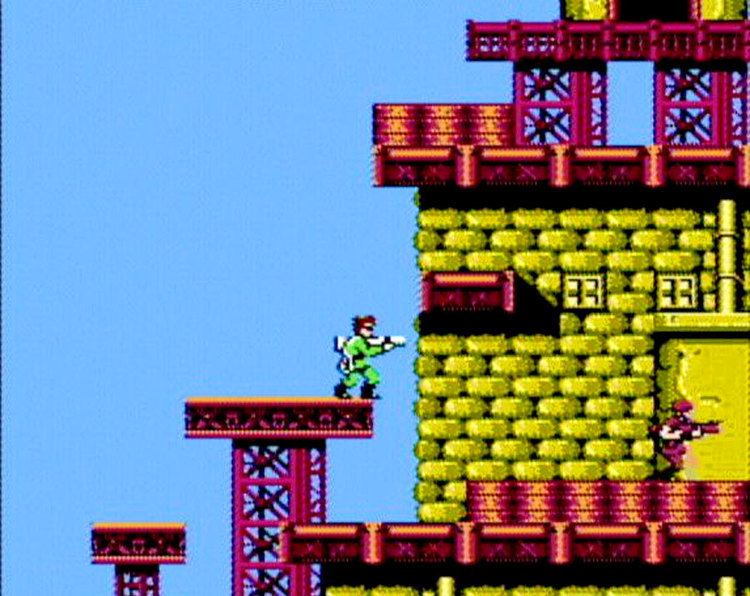 | ||||||||||||||||||||||||||||||||||
Release date(s) JP: July 20, 1988NA: December 1988EU: October 26, 1990 Platform games Bionic Commando Rearmed, Blaster Master, Strider, Legendary Wings, Viewtiful Joe | ||||||||||||||||||||||||||||||||||
Bionic Commando, originally released as Hitler's Revival: Top Secret (ヒットラーの復活
Contents
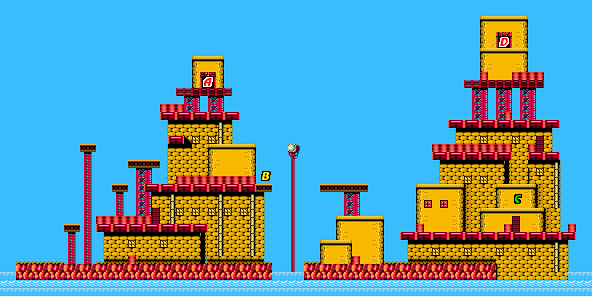
As Ladd Spencer, a member of the FF Battalion, the player has to explore each stage and obtain the necessary equipment to progress. Ladd is equipped with a mechanical arm featuring a grappling gun, allowing him to pull himself forward or swing from the ceiling. As such, the series is one of few instances of a platform game in which the player cannot jump. To cross gaps or climb ledges, Ladd must use his bionic arm.
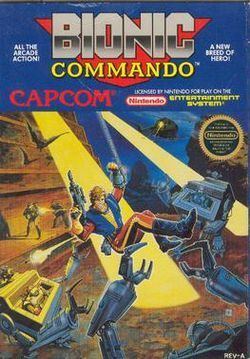
Gameplay

Bionic Commando is a platforming video game in which the player controls Ladd Spencer, whose mission is to rescue Super Joe and to uncover the mystery behind the Albatros project. Players navigate through the game via an overworld map, which they can move from one numbered area to another in a nonlinear fashion. Starting at Area 0, players can move Ladd's helicopter to any connected area on the map. However, once Ladd's helicopter starts to move, the enemy ground vehicles will also move. Once the helicopter reaches its destination without crossing over the path of an enemy vehicle, the player can choose to "descend" and play that area or to "transfer" to a different area. However, if the helicopter intercepts with an enemy vehicle, then Ladd must engage the enemy in an overhead perspective. In this perspective, players use the directional pad to navigate Ladd through the scene, and they can use the buttons to shoot down the enemy. One of the enemies will drop an Eagle-shaped mark when killed, which players can collect for an extra continue.

When Ladd descends into an area, players are taken to a "Weapon Selection" screen, which they must choose one weapon, protective piece of equipment, special weapon, and communication device to use. After selecting the equipment, Ladd is then dropped into the area, which the 2D platforming gameplay begins. Players use the control pad to move Ladd left and right, and the buttons to fire at enemies. In the platforming mode, Ladd is unable to jump, so players must use his bionic arm to navigate platforms and obstacles. Players can extend his bionic arm overhead, directly in front, and above at a 45-degree angle. The bionic arm is used to climb up to higher platforms, swing across chasms, and pick up some items. Planning out moves and timing is necessary to complete areas. There are two types of areas in the game - "combat areas" in which players must fight through and "neutral areas" in which additional information and items may be collected. If Ladd fires his weapon in any neutral area, an alarm sounds, and other combatants will start fighting.
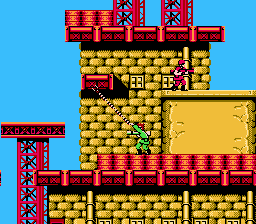
In the combat areas, Ladd must first find the communications room, which Ladd can use to communicate with comrades and to "wire-tap" and listen in on enemy conversations - gathering important information in the process. After using the communications room, a door to the remainder of the area will open. At this point, the player may need to access another communication room to gain further access, depending on the area. At the end of the area is a room that contains a mechanical core guarded by a boss; the player must get past the boss in order to destroy the core, clearing the area. At the end of each area, Ladd obtains additional items or weapons as a bonus, some of which are necessary to access different areas. Additional weapons include wider-range guns, 3-way guns, bazookas, and Super Joe's machine gun. Other items include the flare bomb to illuminate dark caves, medicine to restore energy, permits to access certain areas, protective gear that repels enemy bullets, extra communicators, bullets that help extend energy, and 1-ups. Players may need certain items and equipment to access new areas, which may require going back to previous areas to get them.
Plot
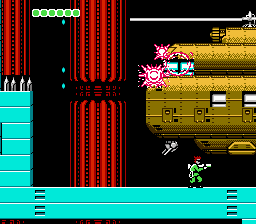
Bionic Commando takes place sometime in 1980s and centers on two warring states: the Federation and the Empire. One day, Federation Forces discover top secret documents about "Albatros", an unfinished project developed by the Empire's predecessor, the "Badds" (also known as the "Nazz"). Imperial leader Generalissimo Killt decides to complete the project himself. Upon learning the Empire's plot, the Federation sends in their national hero, Super Joe (the main character from the 1985 Capcom title Commando) to infiltrate the Empire, but he is captured. The Federation then sends in a second operative named Ladd Spencer to rescue him and to uncover the secret behind the Albatros project. Ladd is a member of the FF (Double Force) Battalion, a team of commandos specially trained to use wired guns to infiltrate enemy bases.
Ladd starts in Area 1, in which he is told that the first several areas, already infiltrated by Federation troops, have communication devices and rooms that can be used to stay in contact with the Federation and for wiretapping to gain intelligence from the Empire. Upon reaching Area 3, Ladd finds through enemy intelligence that Super Joe has been transported to the Imperial "disposal area", which a Federation spy later confirms. However, upon reaching the disposal area, an Imperial commander tells Ladd that Super Joe has been transported elsewhere. Eventually, Ladd rescues Super Joe, who gives Ladd information that the Empire is trying to do what the Badds could not accomplish - to build a powerful laser cannon. However, the person with the most pertinent information about its completion, Master-D, is dead, and Generalissimo Killt has been unsuccessfully trying to resurrect him. Super Joe tells Ladd that they must stop Killt before he succeeds, and he asks Ladd to accompany him to the Imperial base located in Area 12.
When Ladd reaches the Imperial base, Super Joe tells him to break the power system in order to release two power barriers that are guarding the incomplete project. After doing so, Super Joe tells Ladd to defeat Killt and escape while he goes to destroy the base's power source. When Ladd reaches Killt's chamber, Killt tells him that he is too late and that he has completed the Albatros project without needing to resurrect Master-D, turning off the device that would have resurrected him. As Killt is about to attempt to kill Ladd, electric shocks begin to occur around the holding tank containing Master-D's body, reviving Master-D and instantly killing Killt. Master-D then exits the tank and approaches Ladd, saying that he will use the Federation's forces to take over the world. Ladd vows to fight against Master-D, who calls Ladd a "damn fool" and unveils the Albatros. After destroying the Albatros, Ladd encounters a dying comrade named Hal, who gives Ladd a bazooka and tells him that Master-D is escaping and that he needs to shoot the bazooka into the cockpit of Master-D's escape chopper. Ladd uses his bionic arm to swing himself towards Master-D's escape chopper and fires the bazooka into the cockpit; upon doing so, Ladd screams: "Your number's up! Monster!" Then, in a series of slow-motion frames, the game shows Master-D's head explode.
The alarm inside the Imperial base then sounds off, saying: "This base will explod [sic] in 60 seconds." Ladd manages to escape the base when he realizes that Super Joe is still inside, and he runs back in to rescue him. The Federation's commander then orders the full evacuation of the base, but then, as the base explodes, a chopper appears with Ladd holding on to Super Joe while hooked on the chopper with his bionic arm. Ladd then informs the commander that he has Joe and that they are returning to the Federation base. The game's ending then shows Federation troops around Ladd and Super Joe as they celebrate their victory. Super Joe then says how the Federation has a new hero in Ladd Spencer while saying how different he feels from the praise given by his comrades. Then, after showing the ending credits, the game forwards to August 2, 2010, which an old Super Joe recalls the entire story and hope that it will live on.
Localization
For the release of the international version of the game, several changes were made. All references to Nazism in text and imagery were removed for the English localization. The Empire in the Japanese version was actually a neo-Nazi nation and the Imperial Army's insignia was a Nazi Swastika with a thunderbolt behind it. In the English version, the Nazis were referred as the "Badds" (though the back-story in the American version's manual referred to them as the "Nazz"), the Imperial Army's Swastika insignia was changed into a new one resembling an eagle, and the leader of the villains, originally called Weizmann in the Japanese version, was renamed Killt.
One of the most prominent differences involves the ultimate antagonist of the game, who is meant to be a revived Adolf Hitler in the Japanese version (hence the title). For the English version, the character was renamed "Master-D", but his likeness to Hitler was unchanged. There is a notably gory ending sequence in which Hitler's face explodes, which was kept intact in the English version. Additionally, the word "damn" was left in an end-game dialog sequence of the North American release, which was a rare amount of profanity for an American NES release. All officially-approved Nintendo games released during this time were heavily censored for even the most benign instances of profanity, blood and gore, sexual situations, religious symbolism and ideas, and many other sources of potential controversy.
In addition to the graphical changes, the difficulty of the game was rebalanced and some of the areas were made less difficult.
Music
The music for the game was created by videogame music composer Junko Tamiya, who was credited under the pseudonym "Gondamin". Two songs from the Arcade versions are used in some areas. The music for the original arcade game was developed by Harumi Fujita. Tamiya adapted two of the original arcade tracks (The "Bionic Commando Theme" and "The Powerplant") and expanded the soundtrack by adding several more new songs in the console versions for the Japanese Famicom and the NES ports of the game.
Reception
Nintendo Power ranked it as the 17th best Nintendo Entertainment System video game, describing it as one of the console's most original action games due to the ability to swing. GamesRadar ranked it the fourth best NES game ever made. The staff called it a classic and praised its grappling mechanic.
Remakes and re-releases
A portable adaptation of Bionic Commando was released for the Game Boy in 1992. The Game Boy version is based on the NES game, featuring the same gameplay and stages, as well as a similar plot, but changes the present day setting of the NES version into a futuristic one. A second remake, titled Bionic Commando Rearmed, was developed by GRIN and released in 2008 as a downloadable title for the PlayStation 3, Xbox 360, and PC.
The original NES version of Bionic Commando is one of three NES games featured in the Game Boy Advance compilation Capcom Classics Mini-Mix, the other two games being Strider and Mighty Final Fight.
Novelization
A book was written in the Worlds of Power series of novels based on the NES version. The main character is identified as Jack Markson, who loses an arm when ninjas attack his hotel room and kidnap Super Joe. The Federation replaces his missing limb with a bionic arm that has a grappling hook and a number of other gadgets that are not featured in the game, like a flame thrower and a device that forces prisoners to tell the truth. Like most books in the series, violence was toned down to non-lethality in most cases (he usually shoots enemy soldiers with tranquilizers), although certain events, like the deaths of Hal and Killt, are kept. Much of the game's middle is skimmed over in order to fit it all into the book.
